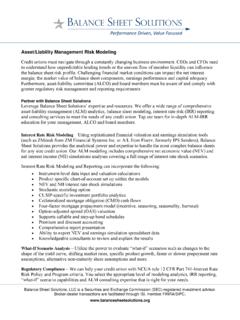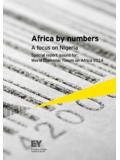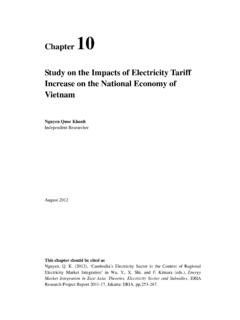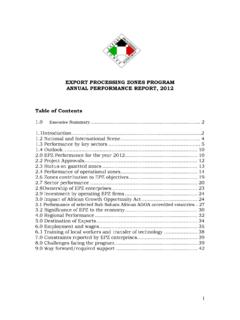Transcription of WEEK OF JULY 23, 2018 Weekly Relative Value
1 WEEK OF APRIL 23, 2018. Weekly Relative Value A Dose of Reality We have seen seven consecutive quarters of accelerating economic growth in the That has only happened one other time in the 1990s. Europe and Japan have also experienced solid growth. As such, Wall Street has eagerly embraced the synchronized global growth . Tom Slefinger is narrative. Senior Vice President, Director of Institutional By its nature of looking backwards and extrapolating into the future, Wall Street is looking for Fixed Income Sales at a continuation of said synchronized growth. I would say that's a major risk. As we enter the Balance Sheet Solutions. second quarter of 2018, the hopes of synchronized growth appear to be vanishing quickly as the global economy suffers a loss of momentum, and warning signs of an imminent slowdown are popping up in the THIS WEEK.
2 A Dose of Reality Outside the The Most Hated Tax Cut Ever We Stand Alone PORTFOLIO STRATEGY. Market Outlook Insights Let's take a quick glance around the world. As we all know, America is driven by consumption, which represents 70% of GDP. The annualized growth rate in real retail sales in Q1 was , which is a sizeable markdown from + in Q4 and the most sluggish quarter since Q1 2009. Please don't tell me how great the American consumer is doing. And as the consumer goes, so goes the economy. BALANCE SHEET SOLUTIONS Weekly Relative Value | 2. Booming stock markets and drove discretionary luxury goods to the highest level in 2017; but as shown below, this luxury goods consumption has already peaked. Single-family starts, the prime housing contributor to GDP growth, has sagged in March to 867 thousand units, a three-month low, and down at a whopping 23% annual rate since last November.
3 Some housing boom! The housing story, at least for two-thirds of the market otherwise known as the single-family home sector, is complete hype. It remains all about apartments and condos. Manufacturing production has slowed from a + annualized path in the final three months of 2017 to + this past quarter. Oh, and what about that ballyhooed tax cut that would offset the tighter monetary policy? The tax relief may be helping keep the stock market, but it is doing very little to help the economy. Roughly 75% of the tax-induced income growth this year has gone into savings, not spending. And as one can easily glean from the graph below, Americans are still tapped out. Do not expect a mass shopping spree anytime soon. Americans are Saving their Tax Cuts BALANCE SHEET SOLUTIONS Weekly Relative Value | 3.
4 Moreover, it seems that the tax relief is going to be diverted towards the gas tank. Americans are expected to be spending an incremental $400 (average per household) on filling up the pumps, draining a big chunk of that average $930 after-tax increase in the paycheck. Higher gasoline prices more than offset the benefits of reduced income taxes for low-income Americans. Have Retail Sales peaked? Probably. Further, there has been no sign that Trump's tax cuts could lift companies' investment spending plans. In the last NFIB. survey, the proportion of respondents planning to increase capital spending decreased to 26%, which seems to indicate that there is more to consider than tax alone when running a business. All told, Q1 real GDP growth in the US looks to be well below the promised 3% escape velocity.
5 I am betting that growth clocks in at a little better than a And there is precious little forward momentum into the current quarter. Note: Q1. GDP is reported this Friday morning. Please do not blame the weather. You don't need to be a meteorologist to know that we tend to get cold weather and snow in the winter months. But this never seems to stop the cheerleaders and stock promoters from reminding us of this fact whenever we manage to post a disappointing Q1 growth quarter. Of course, the earnings fundamentals appear fantastic, but this is what deficit-financed tax cuts and dollar depreciation can deliver. The transitory influences behind the profits story are and will be fading from here on out. By early 2019, the tax cuts fade, the dollar is no longer making new lows, and the lagged effects of the Fed's actions will lead to rising interest expenses.
6 OUTSIDE THE "The latest economic indicators suggest that the growth cycle may have peaked". - Mario Draghi, European Central Bank President BALANCE SHEET SOLUTIONS Weekly Relative Value | 4. The outlook for global growth is turning unequivocally bearish. Look no further than Europe, Japan and China. They are all slowing. All-important juggernaut, German economic data continues to disappoint. Is it a combination of cold weather and strikes or something more serious? Signs point to the latter. It's not just Germany. The reset of the Eurozone is weak as well. The Eurozone economic surprise index is down to two- year lows. Which doesn't bode well for the GDP growth. In Japan industrial production growth is slowing and trade activity has been weaker than expected.
7 In the second largest economy in the world, China tried to make up another headline GDP of + for Q1 of 2018 (in line with Q4 of 2017's + , despite most of the major components of GDP having been reported as slowing). Even the locals in Shanghai didn't believe it. With or without China's fabricated data, let's face it the first quarter was a dud for the global economy. Indeed, for all the talk of acceleration GDP growth in Q1 slowed. The Fed, meanwhile, continues to tighten policy and supposedly intends to shrink its balance sheet at an accelerating pace. Elsewhere, the European Central Bank has promised to cease expanding its asset purchases entirely by late this year. Only the Bank of Japan continues to drag its heels, though it has also tapered its rate of asset purchases over the past year.
8 Never has the world been this indebted. To think that the massive debt burden coupled with higher rates won't affect the economy's sensitivity is just naive. BALANCE SHEET SOLUTIONS Weekly Relative Value | 5. THE MOST HATED TAX CUT EVER. Say what? Last week, President Trump took to some bragging assuring America's oppressed taxpayers that happier times beckon. In fact, we are already living the dream. On this Tax Day, America is strong and roaring back. Paychecks are climbing. Tax rates are going down. Businesses are investing in our great country. And most important, the American people are winning.. - President Donald Trump I, and apparently quite a few Americans, beg to differ. President Trump has been sold a bill of goods about the efficacy of tax cuts.
9 This is the only real basis for his mistaken assumption that the economy is fixing to boom with a motley combination of supply-side ideologues and GOP. politicians pandering to their donor base. Tax cuts are not effective if they are deficit-financed late in the cycle, and thereby cause an off-setting spike in bond yields. And they are also not valuable if they fund corporate financial engineering (think stock buybacks) rather than investment in productive assets or if on the individual side, they are temporary. This is not just my opinion. The massive tax cut for corporations, which were already flush with the most amount of cash ever, is apparently not going particularly well with the electorate. Via : The new NBC News/Wall Street Journal poll shows that the tax-cut law, never broadly popular, has sagged in public esteem lately.
10 Just 27 percent of Americans call it a good idea, down from 30 percent in January. A 36 percent plurality call it a bad idea, while the rest have no opinion. Moreover, a majority gives thumbs-down on the plan when asked to consider its potential effects. Just 39 percent foresee a positive impact from a stronger economy, more jobs and more money in their pockets; 53 percent foresee a negative impact from higher deficits and disproportionate benefits for the wealthy and big corporations. The results we've seen so far this earnings season from the major banks make it crystal clear that the tax cut is achieving at least one aim: the further enrichment of the investor class and the shareholders of large corporations. What JP. Morgan had to say last week, along with Citi and Bank of America, seals the deal.







